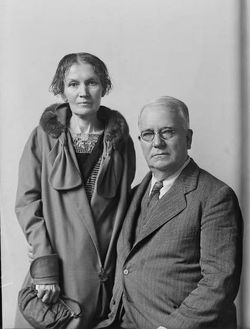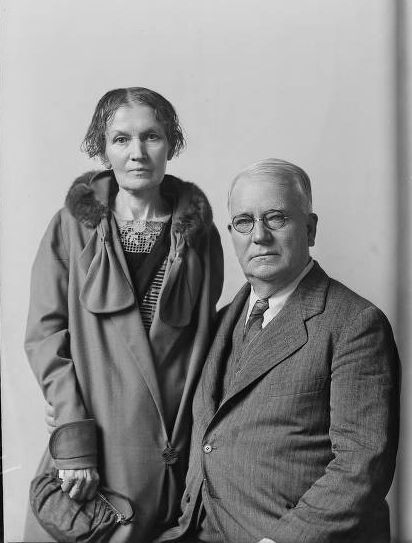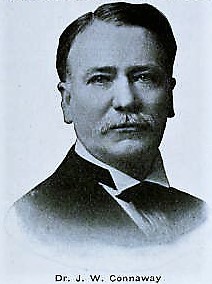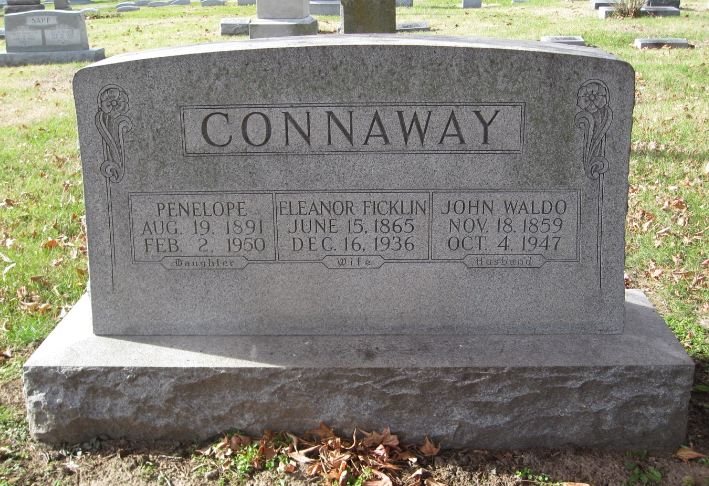Connaway, John Waldo (1859-1947), Papers, 1878-1944 2.2 linear feet
This collection is available at The State Historical Society of Missouri.
INTRODUCTION
The papers of John W. Connaway contain personal and professional correspondence,
research notes and writings, and brief personal material regarding his family. Connaway was Professor of Veterinary Science and Comparative Medicine at the University of Missouri Agricultural Experiment Station from 1888 to 1947 where he made significant findings in controlling Texas fever, hog cholera, brucellosis or Bang's disease, and other farm animal diseases.
DONOR INFORMATION
John W. Connaway donated his papers to the University of Missouri on December 12,
1945 (Accession No. 2818).
BIOGRAPHICAL SKETCH
Born in Stockton, Missouri, on November 18, 1859, John W. Connaway accepted a
position at the University of Missouri Agricultural Experiment Station in 1888. He worked at the university for over fifty years until his death in 1947 although he went into semi-retirement in 1931 when he assumed emeritus status. The University of Missouri honored Dr. Connaway in 1937 by naming a veterinary building after him. Connaway married Eleanor Fricklin of Columbia, Missouri, in 1890. They had one child, Penelope, who was born in 1891.
Connaway received a degree in Veterinary Science from the Chicago Veterinary College in 1890 and obtained a medical degree at the University of Missouri in 1897. He also pursued graduate studies in medicine at the University of Berlin in 1904 and 1905.
During his career Connaway was recognized internationally for his work in eradicating farm animal diseases. His research concerning the Texas fever in the 1890s and 1900s at the Experiment Station helped to control a disease that plagued the cattle industry. He is credited for establishing that a tick was the transmitter of Texas fever in cattle. Connaway developed an immunization schedule for farmers of swine by isolating the cause of hog cholera. He is acknowledged for diagnosing and treating Bang's disease or brucellosis, a contagious abortion in cattle and hogs. Connaway also studied tuberculosis, undulant fever, ranilla of cattle, dairying, foot and mouth disease, and other livestock disorders.
Connaway was also interested in other subjects as well. He was especially concerned with the mentally handicapped. His daughter Penelope, who developed mental problems as a young woman, brought Dr. Connaway's attention to the need for more funding and better facilities at state hospitals. When one of his acquaintances, who was placed in a state hospital, was ruled legally incompetent to run his own business, Connaway came to his aid. He wrote letters and appeared as a witness in his defense. Etymology was another interest. This hobby sometimes branched into his career of veterinary medicine, such as when he researched the history of cattle disease names.
SCOPE AND CONTENT NOTE
The papers of John W. Connaway contain personal and professional correspondence, research notes and writings, and brief personal material regarding his family. The papers were first processed after he donated the collection in 1945. It was grouped into four series: Financial, Composition and Notes, Correspondence, and Miscellaneous information that included material about his family. A new arrangement was made in 1995 that consists of three series: Correspondence, Writings, and Miscellaneous. The former Financial series was consolidated into one folder and placed in the Miscellaneous series, and the Writings series was originally the Composition and Notes series.
The Correspondence series (1879-1944) consists of professional correspondence addressing Dr. Connaway's research. Much of the correspondence during the 1890s and 1900s is between Connaway and Missouri and Texas cattle companies, including the King Ranch in Texas. Other correspondence is with agricultural universities and colleges, veterinarians, farmers, and state and federal farm agencies across the United States. There are some letters from Europeans and South Americans interested in his research as well.
Most of the personal correspondence is with his family members. There are also letters concerning Dr. Connaway's interest in etymology and his concern for the mentally challenged. A few pieces of correspondence deal with his daughter's hospitalization at state facilities in Fulton and Farmington, Missouri. A considerable amount of the later correspondence from Connaway is either handwritten, first-draft pieces or handwritten copies of the letters. Some of these are unfinished or incomplete. The Correspondence series is arranged chronologically.
Arranged alphabetically by type of material, the Writings series (1888-1943) includes items primarily written by Connaway such as: research notes, reports, speeches, school notes, reprint articles, poetry, and a diary. Dr. Connaway's veterinary notes regarding Texas fever, brucellosis or Bang's disease, undulant fever, tuberculosis, dairying, and other farm animal disorders are in this series. Most of his research notes are from his experiments at the University of Missouri Agricultural Experiment Station and studies by others. His school notes were taken during his studies at the Chicago Veterinary College and the University of Berlin. There are also a few articles and speeches written by others in this series.
Connaway's etymology notes are included here. These notes concern his interest in the word "shamrock" and in the names of numbers, fruits, and cattle diseases. There are also notes concerning Missouri and American place names. These are fairly extensive, especially the notes about the word "shamrock."
This series also contains miscellaneous writings by Connaway. There are brief notes concerning the mentally ill and Roy Newman, an acquaintance, who received Connaway's assistance in contesting a legal ruling to keep Newman from operating his business because of mental problems. Brief notes about Biblical quotations, British writers, and poetry in agriculture are included. There are also several folders of poetry written by Connaway about his friends, family members, and colleagues.
The last series, Miscellaneous (1878-1940), primarily contains material about Dr. Con- naway's family. There is some financial information in the form of receipts from Columbia, Missouri, merchants and a household account book. Dr. Connaway's and his wife Eleanor Fricklin's college diplomas are in this series. Some material concerning his daughter Penelope is also included. Some of the pictorial items are images of himself and his extended family members, as well as images from some of his research. A scrapbook dating 1878 to 1884 consists of newspaper clippings about famous writers and world events. The Miscellaneous series is arranged alphabetically by type of material.
Connaway, John Waldo (1859-1947), Papers, 1878-1944 2.2 linear feet
This collection is available at The State Historical Society of Missouri.
INTRODUCTION
The papers of John W. Connaway contain personal and professional correspondence,
research notes and writings, and brief personal material regarding his family. Connaway was Professor of Veterinary Science and Comparative Medicine at the University of Missouri Agricultural Experiment Station from 1888 to 1947 where he made significant findings in controlling Texas fever, hog cholera, brucellosis or Bang's disease, and other farm animal diseases.
DONOR INFORMATION
John W. Connaway donated his papers to the University of Missouri on December 12,
1945 (Accession No. 2818).
BIOGRAPHICAL SKETCH
Born in Stockton, Missouri, on November 18, 1859, John W. Connaway accepted a
position at the University of Missouri Agricultural Experiment Station in 1888. He worked at the university for over fifty years until his death in 1947 although he went into semi-retirement in 1931 when he assumed emeritus status. The University of Missouri honored Dr. Connaway in 1937 by naming a veterinary building after him. Connaway married Eleanor Fricklin of Columbia, Missouri, in 1890. They had one child, Penelope, who was born in 1891.
Connaway received a degree in Veterinary Science from the Chicago Veterinary College in 1890 and obtained a medical degree at the University of Missouri in 1897. He also pursued graduate studies in medicine at the University of Berlin in 1904 and 1905.
During his career Connaway was recognized internationally for his work in eradicating farm animal diseases. His research concerning the Texas fever in the 1890s and 1900s at the Experiment Station helped to control a disease that plagued the cattle industry. He is credited for establishing that a tick was the transmitter of Texas fever in cattle. Connaway developed an immunization schedule for farmers of swine by isolating the cause of hog cholera. He is acknowledged for diagnosing and treating Bang's disease or brucellosis, a contagious abortion in cattle and hogs. Connaway also studied tuberculosis, undulant fever, ranilla of cattle, dairying, foot and mouth disease, and other livestock disorders.
Connaway was also interested in other subjects as well. He was especially concerned with the mentally handicapped. His daughter Penelope, who developed mental problems as a young woman, brought Dr. Connaway's attention to the need for more funding and better facilities at state hospitals. When one of his acquaintances, who was placed in a state hospital, was ruled legally incompetent to run his own business, Connaway came to his aid. He wrote letters and appeared as a witness in his defense. Etymology was another interest. This hobby sometimes branched into his career of veterinary medicine, such as when he researched the history of cattle disease names.
SCOPE AND CONTENT NOTE
The papers of John W. Connaway contain personal and professional correspondence, research notes and writings, and brief personal material regarding his family. The papers were first processed after he donated the collection in 1945. It was grouped into four series: Financial, Composition and Notes, Correspondence, and Miscellaneous information that included material about his family. A new arrangement was made in 1995 that consists of three series: Correspondence, Writings, and Miscellaneous. The former Financial series was consolidated into one folder and placed in the Miscellaneous series, and the Writings series was originally the Composition and Notes series.
The Correspondence series (1879-1944) consists of professional correspondence addressing Dr. Connaway's research. Much of the correspondence during the 1890s and 1900s is between Connaway and Missouri and Texas cattle companies, including the King Ranch in Texas. Other correspondence is with agricultural universities and colleges, veterinarians, farmers, and state and federal farm agencies across the United States. There are some letters from Europeans and South Americans interested in his research as well.
Most of the personal correspondence is with his family members. There are also letters concerning Dr. Connaway's interest in etymology and his concern for the mentally challenged. A few pieces of correspondence deal with his daughter's hospitalization at state facilities in Fulton and Farmington, Missouri. A considerable amount of the later correspondence from Connaway is either handwritten, first-draft pieces or handwritten copies of the letters. Some of these are unfinished or incomplete. The Correspondence series is arranged chronologically.
Arranged alphabetically by type of material, the Writings series (1888-1943) includes items primarily written by Connaway such as: research notes, reports, speeches, school notes, reprint articles, poetry, and a diary. Dr. Connaway's veterinary notes regarding Texas fever, brucellosis or Bang's disease, undulant fever, tuberculosis, dairying, and other farm animal disorders are in this series. Most of his research notes are from his experiments at the University of Missouri Agricultural Experiment Station and studies by others. His school notes were taken during his studies at the Chicago Veterinary College and the University of Berlin. There are also a few articles and speeches written by others in this series.
Connaway's etymology notes are included here. These notes concern his interest in the word "shamrock" and in the names of numbers, fruits, and cattle diseases. There are also notes concerning Missouri and American place names. These are fairly extensive, especially the notes about the word "shamrock."
This series also contains miscellaneous writings by Connaway. There are brief notes concerning the mentally ill and Roy Newman, an acquaintance, who received Connaway's assistance in contesting a legal ruling to keep Newman from operating his business because of mental problems. Brief notes about Biblical quotations, British writers, and poetry in agriculture are included. There are also several folders of poetry written by Connaway about his friends, family members, and colleagues.
The last series, Miscellaneous (1878-1940), primarily contains material about Dr. Con- naway's family. There is some financial information in the form of receipts from Columbia, Missouri, merchants and a household account book. Dr. Connaway's and his wife Eleanor Fricklin's college diplomas are in this series. Some material concerning his daughter Penelope is also included. Some of the pictorial items are images of himself and his extended family members, as well as images from some of his research. A scrapbook dating 1878 to 1884 consists of newspaper clippings about famous writers and world events. The Miscellaneous series is arranged alphabetically by type of material.
Inscription
Husband
Family Members
Sponsored by Ancestry
Advertisement
Explore more
Sponsored by Ancestry
Advertisement
















